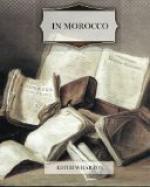III
FEZ ELBALI
The distances in Fez are so great and the streets so narrow, and in some quarters so crowded, that all but saints or humble folk go about on mule-back.
In the afternoon, accordingly, the pink mules came again, and we set out for the long tunnel-like street that leads down the hill to the Fez Elbali.
“Look out—’ware heads!” our leader would call back at every turn, as our way shrank to a black passage under a house bestriding the street, or a caravan of donkeys laden with obstructive reeds or branches of dates made the passers-by flatten themselves against the walls.
On each side of the street the houses hung over us like fortresses, leaning across the narrow strip of blue and throwing out great beams and buttresses to prop each other’s bulging sides. Windows there were none on the lower floors; only here and there an iron-barred slit stuffed with rags and immemorial filth, from which a lean cat would suddenly spring out, and scuttle off under an archway like a witch’s familiar.
[Illustration: From a photograph from the Service des Beaux-Arts au Maroc
Fez—a reed-roofed street]
Some of these descending lanes were packed with people, others as deserted as a cemetery; and it was strange to pass from the thronged streets leading to the bazaars to the profound and secretive silence of a quarter of well-to-do dwelling-houses, where only a few veiled women attended by negro slaves moved noiselessly over the clean cobblestones, and the sound of fountains and runnels came from hidden courtyards and over garden-walls.
This noise of water is as characteristic of Fez as of Damascus. The Oued Fez rushes through the heart of the town, bridged, canalized, built over, and ever and again bursting out into tumultuous falls and pools shadowed with foliage. The central artery of the city is not a street but a waterfall, and tales are told of the dark uses to which, even now, the underground currents are put by some of the dwellers behind the blank walls and scented gardens of those highly respectable streets.
The crowd in Oriental cities is made up of many elements, and in Morocco Turks, Jews and infidels, Berbers of the mountains, fanatics of the confraternities, Soudanese blacks and haggard Blue Men of the Souss, jostle the merchants and government officials with that democratic familiarity which goes side by side with abject servility in this land of perpetual contradictions. But Fez is above all the city of wealth and learning, of universities and counting-houses, and the merchant and the oulama[A]—the sedentary and luxurious types—prevail.
[Footnote A: Learned man, doctor of the university.]
The slippered Fazi merchant, wrapped in white muslins and securely mounted on a broad velvet saddle-cloth anchored to the back of a broad mule, is as unlike the Arab horseman of the desert as Mr. Tracy Tupman was unlike the Musketeers of Dumas. Ease, music, money-making, the affairs of his harem and the bringing-up of his children, are his chief interests, and his plump pale face with long-lashed hazel eyes, his curling beard and fat womanish hands, recall the portly potentates of Hindu miniatures, dreaming among houris beside lotus-tanks.




